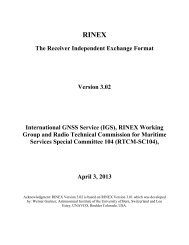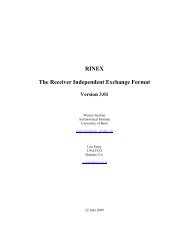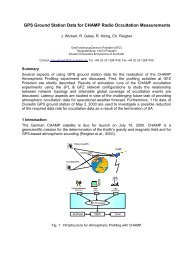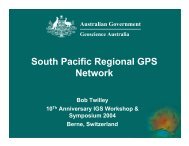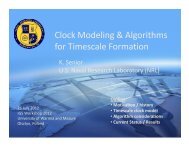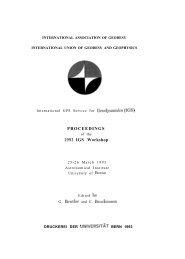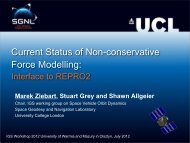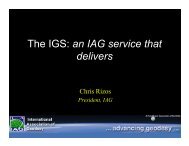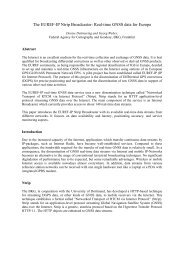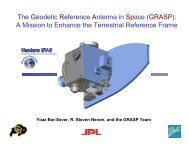IGS Analysis Center Workshop - IGS - NASA
IGS Analysis Center Workshop - IGS - NASA
IGS Analysis Center Workshop - IGS - NASA
Create successful ePaper yourself
Turn your PDF publications into a flip-book with our unique Google optimized e-Paper software.
errors, and can therefore be used as calibrations to produce common station data that hassubstantially reduced noise.Theoretically, if we calibrate data for the post-fit residuals and feed only a subset of thatcalibrated data back into the estimation process, it can be easily shown that we get exactlythe same solution (provided there is sufficient data to prevent a rank deficiency).Therefore, we can think of this calibrated data set as simply a different representation of theGAC’s solution. Note that there is no reason to use carrier phase any more: we can just aseasily calibrate the pseudorange data provided the GAC has reduced the pseudorange andcarrier phase data simultaneously in the filter. We therefore no longer have to estimatecarrier phase ambiguity parameters when reusing this “noise-calibrated pseudorange,”When using such calibrated data for a common station in a regional network, it is importantto heavily weight that data relative to the raw data from other stations. Theoretically, onemight expect that the determination of a baseline from a regional station to a common noisecalibratedstation will be improved by ti. In practice, we should recognize that the post-fitresiduals we would have obtained were the regional station in the global solution, wouldhave been correlated to some degree. These correlations can arise, for example, from orbitrnismodeling or antenna phase center variations. Such correlated errors will be absorbed inpart by the satellite clock parameters when computing the regional solution (or equivalently,will be difference away). But there is a potential problem when we calibrate the noisefrom only one station’s data when that noise is correlated with a nearby station. Theregional solution can no longer absorb this correlated component of error.Hence the question of how much improvement can be expected depends upon the degree towhich post-fit residuals are correlated, and can only be answered by tests with real data,which will be done shortly. It is potentially a powefil tool for reducing multipath effectsat the common sites.4.1 Introduction4. EXAMPLESAn examination of the current list of operational <strong>IGS</strong> tracking stations (Figure 7) revealsthat several distinct regional clusters are already in operation today, e.g., The “WesternEuropean cluster”, the “Canadian cluster” the Western Canadian Geodetic Array (WCDA)[Draggert et al., 1993] in British Columbia, and the Permanent GPS Geodetic Array(PGGA) in southern California, The first two clusters serve primarily as active controlnetworks while the latter two clusters have been designed to study the kinematics of plateboundary deformation and can be considered among the first <strong>IGS</strong> customers. In thissection we present several scenarios and examples of distributed processing by referring toPGGA/<strong>IGS</strong> activities at Scripps Institution of Oceanography (S10). In the nomenclature ofthis paper, S10 plays the role of a GAC, NAC and RAC.4.2 The Permanent GPS Geodetic ArrayThe Permanent GPS Geodetic Array (PGGA) is a network of continuously operating P-code receivers providing an uninterrupted record of crustal motion in near real time (Figure7) [Bock and Shimaa’a, 1990; Bock, 1991; Lindqwister et aL, 1991], Stations are spacedapproximately 100 km apart to span the Pacific-North American plate boundary in southernCalifornia. The ability of the PGGA to monitor crustal deformation due to seismicity wasdemonstrated during the Landers earthquake sequence in June 1992, when small far-fieldcoseismic displacements were accurately detected at all PGGA stations with respect to the79




